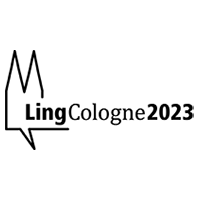Click on the link above to download the conference's book of abstracts.
Program
Date: June 6–7, 2019
Venues: Aula 2, Neuer Senatssaal, Dozentenzimmer, University of Cologne, main building
June 5
| 02:00 p.m. | Satellite Workshop: NEUROGES (Separate registration required) |
| 08:00 p.m. | Get-together, beer garden/restaurant Stadtgarten |
June 6
| 08:30 a.m. | Registration |
| 09:00 a.m. | Welcome |
| 09:15 a.m. | Poster flash talks (60 seconds/poster) |
| 09:30 a.m. | GESTURE/SIGN Roland Pfau: Headshakes – from gesture to grammar |
| 11:00 a.m. | Coffee break |
| 11:30 a.m. | GESTURE/SPOKEN Katharina Rohlfing: Learning language from the use of gestures |
| 01:00 p.m. | Lunch |
| 02:00 p.m. | SIGN/SPOKEN/WRITTEN Kate Rowley: Visual word recognition in deaf readers |
03:30 p.m. | Coffee break / Poster session
Click to display the poster presenters
- Anna Blöcher (3): Influence of Written Syllable Shape on Oral Reading? Evidence from an Eye Tracking Experiment
- Anne Bragard (4): “Assisted kinemes alphabet” (AKA) as a support of phonological development in preschool deaf children
- Anne Bragard & Marie-Anne Schelstraete (5): Using gestures to help children with specific language impairment in word learning
- Chris Brozdowski (6): Purposeful and Transitional Velocity among Sign Language Users
- Cornelia Ebert, Robin Hörnig, Susanne Fuchs, Aleksandra Cwiek, Manfred Krifka (9): Experimental studies on co-speech gestures and their (non-)at-issueness
- Mary Edward (10): Language of the hands: Comparing signers and gesturers representation of lexical items
- Volker Gast & Daniel Hole (12): Annotating deictics and gesticulations: A data model, a multi-level annotation scheme and software
- Maria Kyuseva (16): Russian Sign Language size and shape specifiers and how they differ from gesture
- Cornelia Loos, Marlijn Meijer, Markus Steinbach, Sophie Repp (17): Multimodal responses: A typological perspective on yes and no in German Sign Language
- Lilia Rissman, Laura Horton, Susan Goldin-Meadow (22): Event categories in the manual modality: a cross-cultural study of child homesign
- Shinji Sako (24): Discussion of a Japanese sign language database and its annotation systems with consideration for its use in various areas
- Matthias Knopp & Kirsten Schindler (25): Multimodal Elements in Students’ Texts – Two Case Studies
- Beyza Sümer, Francie Manhardt, Kimberley Mulder, Dilay Karadöller, & Aslı Özyürek (28): Signers have better memory than speakers for object locations displayed on a lateral versus sagittal axis
- Stefanie Türk, Ulrike Domahs (29): Do orthographic representations influence spoken language processing in the second language?
- Ingrid Vilà-Giménez (32): Beat gestures and narrative development: Training children in producing rhythmic hand gestures promotes immediate gains in their discourse performances
- Claudia Wegener, Jana Bressem (33): Sharing the load – the interplay of verbal and gestural negation in Savosavo
- Marzena Zygis, Susanne Fuchs (34): How prosody, speech mode and speaker visibility influence lip aperture
|
| 05:00 p.m. | SPOKEN/WRITTEN Anton Stepikhov: The effect of individual psychological profile on syntactic segmentation of spontaneous speech |
| 07:00 p.m. | Conference Dinner |
June 7
| 09:15 a.m. | Poster flash talks (60 seconds/poster) |
| 09:30 a.m. | GESTURE/SIGN Wendy Sandler: The Composition of a Theatrical Sign Language |
| 11:00 a.m. | Coffee break |
| 11:30 a.m. | GESTURE/SPOKEN Asli Özyürek: Using and Processing Language in Multimodal Context: Insights from Brain and Behavior |
| 01:00 p.m. | Lunch |
| 02:00 p.m. | SIGN/SPOKEN/WRITTEN Deanna Gagne: Multimodality in hearing native signers |
03:30 p.m. | Coffee break / Poster session
Click to display the poster presenters
- Anastasia Bauer and Roman Poryadin (2): The interplay of written and sign language. The first corpus-based analysis of fingerspelling and its functions in Russian Sign Language (RSL)
- Hanna Bruns (7): “… or this could be like the gender map and somebody is not even on it” – The conceptualization of gender through speech and gesture
- Sandy Ciroux (8): Multimodal Communicative Acts: What Words Cannot Do Without a Hand
- Martin Evertz (11): The history of the graphematic foot in the writing systems of English and German
- Yifei He (13): The role of body orientation during gesture-speech integration: evidence from EEG
- Marieke Hoetjes, Lieke van Maastricht, Ellen van Drie (14): Can gestures facilitate the acquisition of lexical stress in a second language?
- Kristina Kiehn (15): The influence of fingerspelling on different sign languages
- Francie Manhardt (18): Cross-modal transfer of iconicity: Evidence from bimodal bilinguals
- Ulrich Mertens (19): Children’s viewpoint in gesture and their relation to linguistic structure
- Varduhi Nanyan (20): Does L2 speech generate a higher gesture rate? A study of Dutch speakers of English
- Gökhan Özkayin (21): Quantity of co-speech gestures in children's narratives: A study of formal vs. informal language
- Ellen Rombouts, Bea Maes, & Inge Zink (23): Gesturing strategies and verbal-visuospatial profiles of atypically developing children
- Melanie Schippling (26): Editing processes in the transition from speech to writing: The case of Romani
- Gediminas Schüppenhauer, Katarzyna Stoltmann (27): Divergent rehearsal strategies in DGS-German bilinguals vs. German monolinguals during memory span tasks
- Olena Tykhostup (30): Multimodality of reported speech and thought in Russian
- Jessica Vaupel (31): How the CONTAINER schema underlies gestures in multimodal descriptions of temporal concepts
|
| 05:00 p.m. | SPOKEN/WRITTEN Emmanuel Dupraz: Written formulae, spoken formulae, acted formulae: on the interaction between writing and speaking in ancient ritual and juridical operations |
Take to Social Media to share your LingCologne story!
